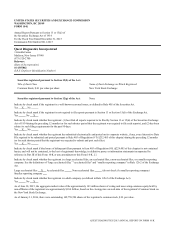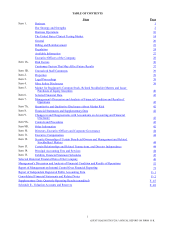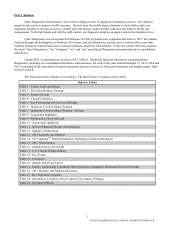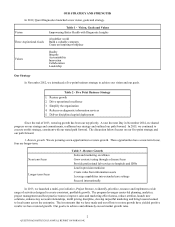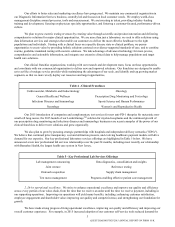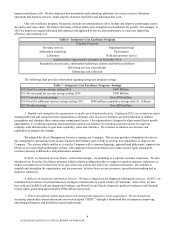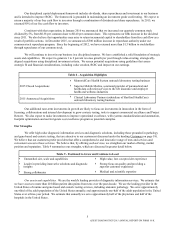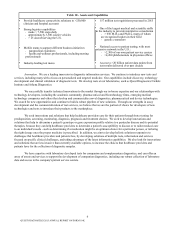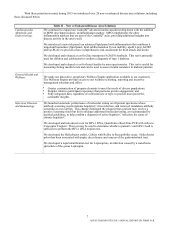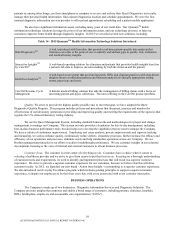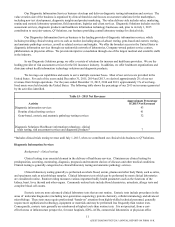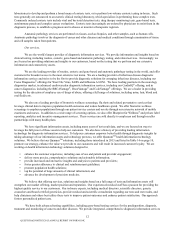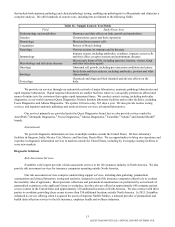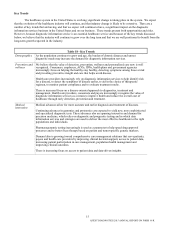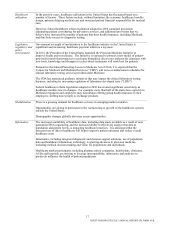Quest Diagnostics 2015 Annual Report Download - page 12
Download and view the complete annual report
Please find page 12 of the 2015 Quest Diagnostics annual report below. You can navigate through the pages in the report by either clicking on the pages listed below, or by using the keyword search tool below to find specific information within the annual report.
8
Neurology We introduced the first personalized genetic diagnostic test of the entire human genome in
partnership with Personalis, Inc., to specifically help diagnose neurological disorders.
We launched a series of new advanced sequencing molecular tests to more reliably and quickly
diagnose hundreds of clinically relevant genetic causes of muscular dystrophies and myopathies
in adults and children. These tests help avoid painful muscle biopsies that, in the past, were the
only means to diagnose patients with muscle weakness.
We launched advanced sequencing molecular tests to test for hundreds of genetic causes of rare,
progressive movement disorders called hereditary ataxias, which affect movement of the legs
and hands, and speech and eye movements. Patients benefit from a molecular diagnosis by
eliminating the need for further testing and identifying a basis for therapies to extend mobility
and life.
We also launched advanced sequencing molecular tests to test for hundreds of genetic causes of
rare, progressive movement disorders called hereditary spastic paraplegias, which are
characterized by a slowly progressive stiffness and weakness of the legs. The diagnosis guides
physicians in the use of medications to reduce muscle tightness.
Oncology We introduced LeukoVantageTM, a genomic test service that aids in the diagnosis, prognosis
monitoring and selection of treatment for myeloid neoplasms, a group of hematologic
malignancies that include acute myeloid leukemia.
We introduced access to a companion test service for a new anti-PD-1 therapy for metastatic
non-small cell lung cancer developed by Merck and a complementary test service for a new
anti-PD-1 therapy for metastatic non-small cell lung cancer developed by Bristol-Myers Squibb.
We introduced a prognostic panel including new probes to aid physicians in treating patients
with plasma cell myeloma.
Prescription Drug
Monitoring and
Toxicology
We introduced a quantitative test for buprenorphine and naloxone. Patients treated with
buprenorphine-naloxone co-formulation will demonstrate both naloxone and buprenorphine/
norbuprenorphine drug analysis. Naloxone is not detected with buprenorphine-only use.
Sports Science and
Human Performance The New York Football Giants began using Blueprint for AthletesTM as a major factor in the
Giants' training and preparation for National Football League games.
We conducted beta programs at select elite endurance events using the Blueprint for AthletesTM
service to empower athletes to track their progress from the onset of training through the event.
Women’s and
Reproductive Health We introduced QNatal AdvancedTM, a new noninvasive prenatal screening service for detecting
chromosomal abnormalities in certain high-risk pregnancies.
We enhanced our HPV offerings with five new tests. One assay is used in connection with
cytology to assess the presence or absence of high risk HPV genotypes 16, 18 and/or 45. This
information together with physician's assessment of cytology history, other risk factors and
professional guidelines may be used to guide patient treatment. The second assay is used in
conjunction with cytology to evaluate anal dysplasia. The other three are used in combination
with cytology, cytology history and other risk factors in aiding the diagnosis of vaginal cancer.
Collaboration. We collaborate with partners that can help us to achieve our vision of empowering better health
through diagnostic insights. Through our relationships, we believe that we are a leader in bringing innovation to the market.
As the industry leader with the largest and broadest U.S. network and a presence outside the United States, we believe we are
the distribution channel of choice for developers of new solutions, including large commercial manufacturers, academic
medical centers and pharmaceutical and biotechnology firms, to introduce their products to the marketplace. We maintain
relationships with advisers and consultants who are leaders in key fields of science and medicine. We work with key groups
and organizations, including world class healthcare leaders, to foster important advances in healthcare, including in precision
medicine. Some examples of our collaborations include:
QUEST DIAGNOSTICS 2015 ANNUAL REPORT ON FORM 10-K


